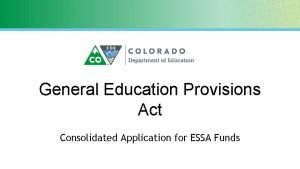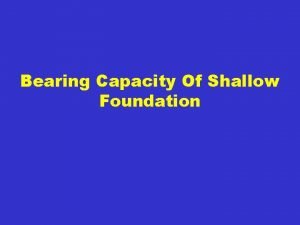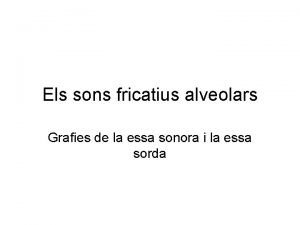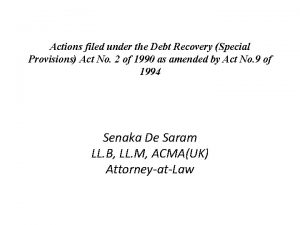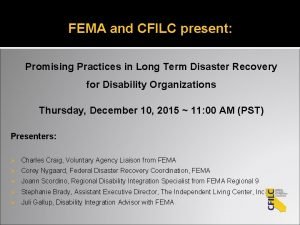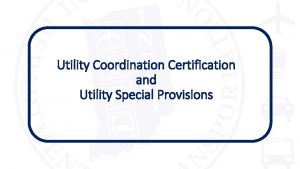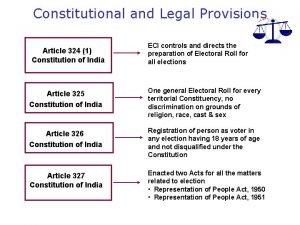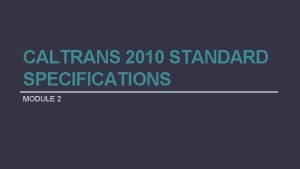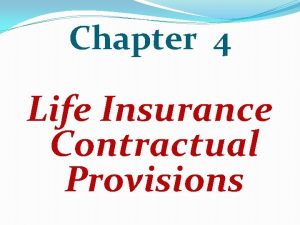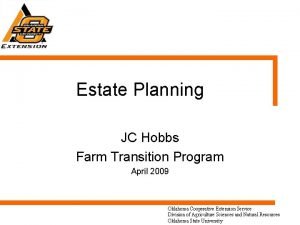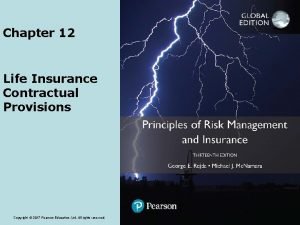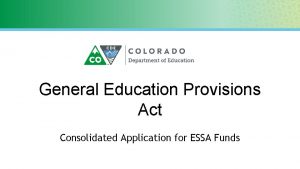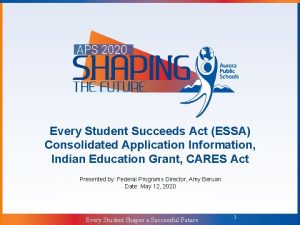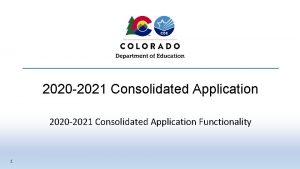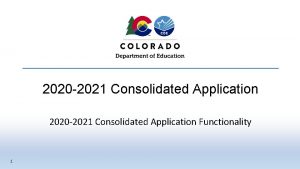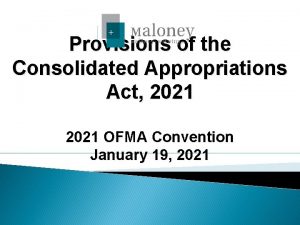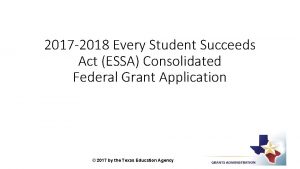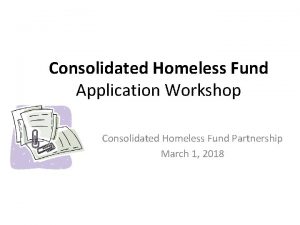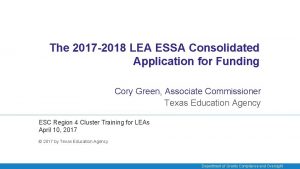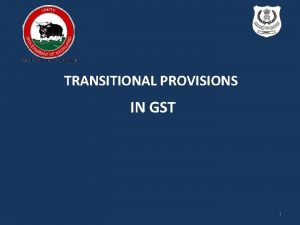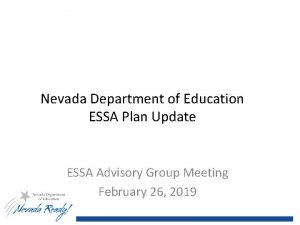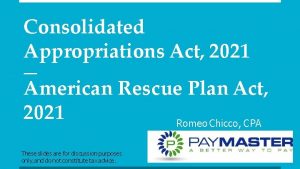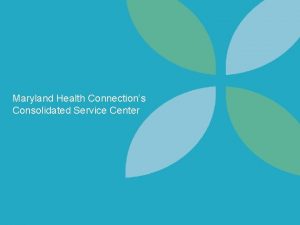General Education Provisions Act Consolidated Application for ESSA



















- Slides: 19

General Education Provisions Act Consolidated Application for ESSA Funds

What is the General Education Provisions Act? Q: What is the General Education Provisions Act (GEPA)? A: GEPA contains a broad array of statutory provisions that are applicable to the majority of federal education programs administered by the U. S. Department of Education (USDE), as well as provisions related to the powers and responsibilities of the USDE.

How does GEPA apply to LEA/BOCES? Q: How does GEPA apply to my LEA/BOCES as a recipient of ESEA funds? A: Section 427, which requires applications for federal funds (i. e. Consolidated Application) to include a description of: • Steps the applicant proposes to take in order to ensure equitable access to, and participation in, its federal-assisted program for students, teachers, and other program beneficiaries. • The description need not be lengthy to satisfy the statement requirements. • CDE is responsible for ensuring that the applicant has submitted a sufficient statement.

Types of Barriers Statute and guidance highlight the possible types of barriers that may be identified, inclusive of students, families and educators Applicants are not required to write a statement for all possible barriers, only those applicable to the LEA’s or BOCES’ local context Possible Barriers to Equitable Access or Participation Gender Race National Origin Color Disability Age Other

Types of Barriers Continued Barriers are not the same as overt discriminatory practices. Civil rights statutes prohibit the use of discriminatory practices in federally-funded programs and the applicant’s creation and implementation of a non-discrimination policy often addresses such requirements. While the LEA’s statement of non-discrimination is supportive of the intent of the GEPA statement, it does not satisfy the GEPA requirement.

General Education Provisions Act continued GEPA, on the other hand, addresses a need to identify barriers to accessing or participating in federally-funded activities. Identifying a barrier does not equate to identifying discriminatory practices; though, if in the process of assessing potential barriers the applicant identifies such practice, it would be incumbent upon the applicant to address and remedy the practice.

General Education Provisions Act: Barrier definition A barrier, as defined, acts to restrain, limit, or obstruct progress or access. Considerations: • How does the LEA or BOCES review behaviors, data, achievement, growth, etc. to identify ways in which students may be prevented from accessing or participating in a federally funded program that would lead to the students’ progress? Consider the information already accessible and utilized by the LEA or BOCES. • • Unified Improvement Plan; Root Causes (LEA- or school-level) Comprehensive needs assessment (LEA- or school-level) Comprehensive Support for Improvement Plan (school-level) Targeted Support for Improvement Plan (school-level)

General Education Provisions Act in 20182019 Consolidated Application The 2018 -2019 Consolidated Application for ESEA Funds will include a table, similar to the one following the examples on upcoming slides, to assist applicants in completing the GEPA statement requirement. Statements such as “No students in our LEA face a barrier of any kind” do not meet the requirements of the GEPA statement and will not be accepted in the 2018 -19 Consolidated Application.

General Education Provisions Act: UIP Example 1 Example of using the UIP to identify and address a barrier to access or participation in a federally funded activity: • The [INSERT LEA OR BOCES] has identified a lack of cultural competency in instruction, specifically in regard to the social, emotional, and academic success of its English learners, as a root cause of low student achievement. The LEA will utilize its Federal funds to provide professional development opportunities for teachers by addressing culturally responsive instructional practices. • A description of how this activity will be implemented would address a barrier to equitable participation based on national origin, thereby satisfying the GEPA requirement.

General Education Provisions Act: UIP Example Continued Barrier Type (Required) National Origin Describe the steps Describe the Describe how the Indicate the funds taken to identify Potential/Existing LEA will mitigate that will support potential/existing Barrier (Including barrier(s) identified these activities barrier(s) (Required) the ESEA program in (Required) which barrier may exist) (Required) UIP a lack of cultural competency in instruction; inhibiting students from fully accessing Title III supports provide professional development opportunities for teachers by addressing culturally responsive instructional practices (including more detailed description) Title II, Part A Notes (Optional)

General Education Provisions Act: UIP Example 2 Example of using the UIP to identify and address a barrier to access or participation in a federally funded activity: • The [INSERT LEA OR BOCES] has identified the disproportionate use of exclusionary discipline practices (removing or excluding students from the classroom), specifically in regard to black, Hispanic, or Native American students, as a root cause of low student achievement. The LEA will utilize their State/local funds to reduce the use of discipline practices that remove students from the classroom • A description of how this activity will be implemented would address a barrier to equitable participation for students of color, thereby satisfying the GEPA requirement.

General Education Provisions Act: UIP Example 2 continued Barrier Type (Required) Color Describe the steps Describe the Describe how the Indicate the funds taken to identify Potential/Existing LEA will mitigate that will support potential/existing Barrier (Including barrier(s) identified these activities barrier(s) (Required) the ESEA program in (Required) which barrier may exist) (Required) UIP disproportionate use of exclusionary discipline practices; inhibiting students from fully accessing and participating in schoolwide programs at the elementary school reduce the use of discipline practices that remove students from the classroom (including more detailed description) State/local Notes (Optional)

General Education Provisions Act: UIP Example 3 Example of using the UIP to identify and address a barrier to access or participation in a federally funded activity: • The [INSERT LEA OR BOCES] has identified lack of student participation in advanced placement STEM courses, specifically in regard to female students as a root cause of low student achievement. The LEA will utilize their Federal funds to increase outreach efforts to female students to encourage enrollment and participation in advanced placement STEM courses • A description of how this activity will be implemented would address a barrier to equitable participation for students based on gender, thereby satisfying the GEPA requirement.

General Education Provisions Act: UIP Example 3 continued Barrier Type (Required) Gender Describe the steps taken Describe the to identify Potential/Existing potential/existing Barrier (Including the barrier(s) (Required) ESEA program in which barrier may exist) (Required) UIP a lack of student participation in advanced placement STEM courses, specifically in regard to female students; inhibiting students from fully accessing benefit of Title IV, Part A program at the high school Describe how the LEA will mitigate the barrier(s) identified (Required) increase outreach efforts to female students, such as field trips to aerospace engineering companies, to encourage enrollment and participation in advanced placement STEM courses (including more detailed description) Indicate the funds that will support these activities (Required) Title I, Part A; Title IV, Part A Notes (Optional)

General Education Provisions Act: UIP Example 4 Example of using teacher perception surveys to identify and address a barrier to access or participation in a federally funded activity: • The [INSERT LEA OR BOCES] has identified low satisfaction with professional development offerings among veteran teachers, resulting in inconsistent implementation of improvement strategies. The LEA will utilize their Federal funds to conduct focus groups with veteran teachers to determine effective strategies for engaging them in improvement efforts. • A description of how this activity will be implemented would address a barrier to equitable participation for students based on age, thereby satisfying the GEPA requirement.

General Education Provisions Act: UIP Example 4 continued Barrier Type (Required) Age Describe the steps Describe the Describe how the Indicate the funds taken to identify Potential/Existing LEA will mitigate that will support potential/existing Barrier (Including barrier(s) identified these activities barrier(s) (Required) the ESEA program in (Required) which barrier may exist) (Required) Teacher perception surveys low satisfaction with professional development offerings among veteran teachers; inhibiting students from fully benefitting from improvement efforts, such as 1003(a) grant opportunities conduct focus groups with veteran teachers to determine effective strategies for engaging them in improvement efforts (including more detailed description) Title II, Part A Notes (Optional)

General Education Provisions Act: Examples Summary The common themes throughout the examples are that: • the statements are written based on root causes specific to the local context of the LEA or BOCES, and • each statement includes the identification of the barrier, as well as the activity that will be or has been implemented to address the barrier.

General Education Provisions Act: Final Clarification The statements DO NOT explicitly state or imply that the LEA or BOCES is discriminating against students due to the existence of a barrier. Acknowledgement of a barrier coupled with an activity to increase accessibility and participation does not in itself demonstrate the LEA’s or BOCES’ intent to discriminate against students. • Rather, it acknowledges areas in which the LEA or BOCES may improve programming so that all students have the equitable opportunity to benefit from the federally supported programming.

Contact Information For questions related to the development of the LEA’s GEPA statement, please contact your ESEA Regional Contact.
 Essa consolidated application
Essa consolidated application Soil bearing capacity
Soil bearing capacity La essa sorda i la essa sonora
La essa sorda i la essa sonora Define decree nisi
Define decree nisi Fema provisions
Fema provisions Indot unique special provisions
Indot unique special provisions Note two effects of allied bombing raids on japan.
Note two effects of allied bombing raids on japan. Article 325
Article 325 Caltrans standard plans 2010 pdf
Caltrans standard plans 2010 pdf Life insurance contractual provisions
Life insurance contractual provisions Trust reporting services
Trust reporting services New hobbs farm and provisions
New hobbs farm and provisions 2015 nehrp recommended seismic provisions
2015 nehrp recommended seismic provisions Common provisions regulation
Common provisions regulation Life insurance contractual provisions
Life insurance contractual provisions Life insurance contractual provisions
Life insurance contractual provisions Macbeth act 3-5 summary
Macbeth act 3-5 summary Consolidated shipping services
Consolidated shipping services The consolidated global group
The consolidated global group What is the purpose of a holding company
What is the purpose of a holding company
